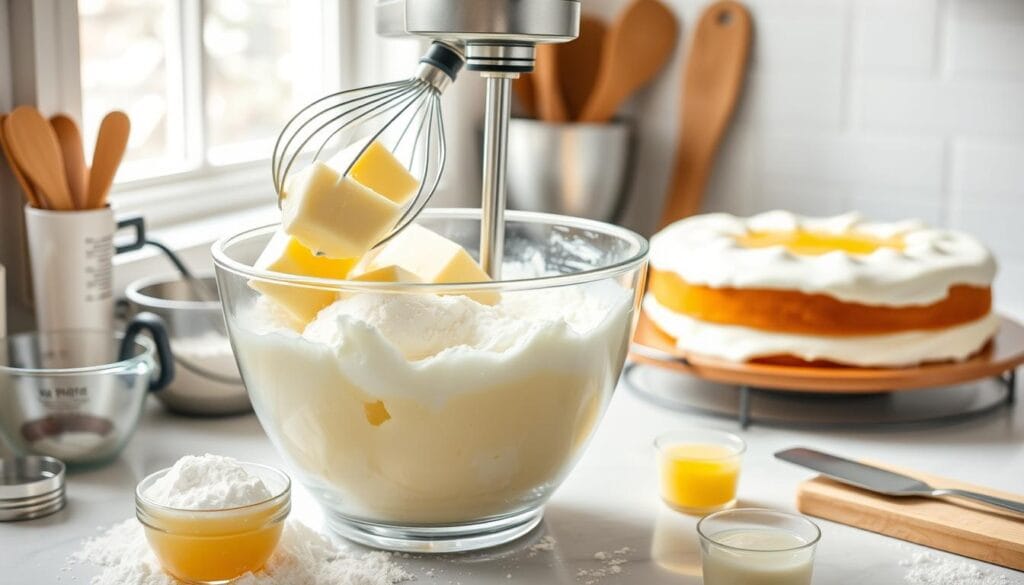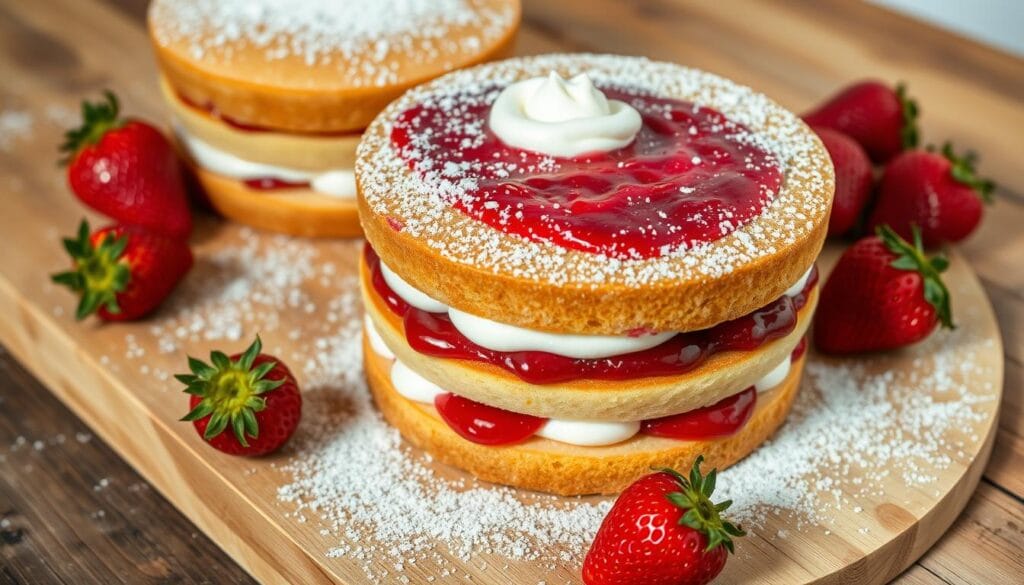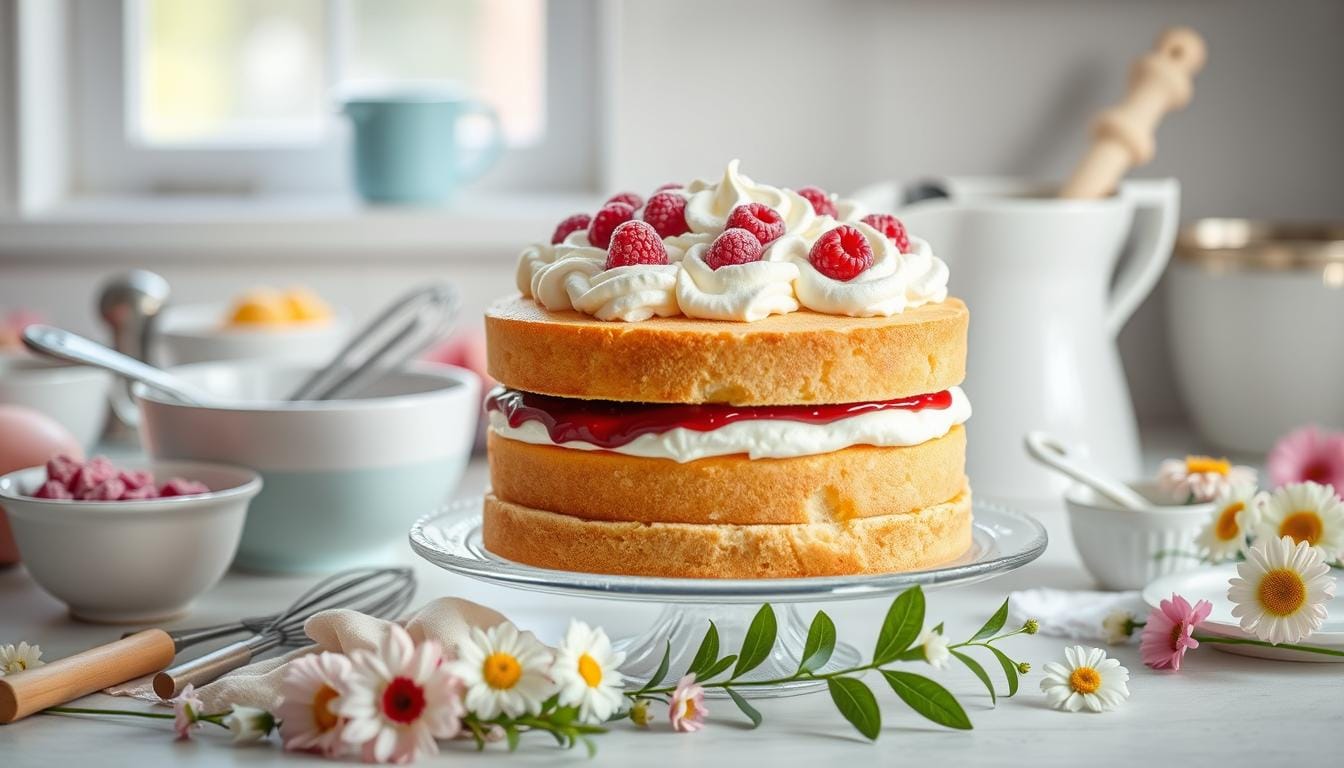Every kitchen has a story, and mine started with a Victoria cake recipe passed down through generations. When the sweet aroma of a traditional sponge cake fills your home, you’ll see why this classic British dessert has won hearts for over a century.
Baking a perfect Victoria cake is more than following a recipe. It’s about creating a culinary experience that connects you to a rich baking tradition. Whether you’re new to baking or have years of experience, this guide will help you make an authentic Victoria sponge cake. It’s sure to impress your family and friends.
Table of Contents
Key Takeaways
- Master the classic British Victoria cake technique
- Learn precise ingredient measurements for a perfect sponge cake
- Understand the importance of temperature and timing in baking
- Discover professional filling and assembly methods
- Create a delicious traditional dessert from scratch
Understanding the History of Victoria Cake
The Victoria Cake is a sweet part of British history, dating back to the Victorian era. It’s more than just a dessert; it connects royal tastes with the joy of afternoon tea.
In the Victorian era, from 1837 to 1901, food changed a lot. New tools like baking powder, created by Alfred Bird in 1843, made cakes lighter and tastier.
Royal Roots and Inspiration
Queen Victoria made this cake famous. Her love for afternoon tea included the Victoria Sponge. It showed off her taste and elegance.
- Named directly after Queen Victoria
- Evolved from a traditional loaf shape to a round cake
- Represented both royal sophistication and home-style comfort
Culinary Evolution
The Victoria Cake changed from a simple sandwich to the classic dessert we know today. Its evolution shows how British baking and social norms changed in the 19th century.
“A slice of Victoria Cake is more than just a treat—it’s a taste of history.”
Afternoon Tea Significance
This cake became a key part of British afternoon tea. It symbolized a cherished tradition. Serving sponge cake with tea showed hospitality and brought people together.
From its royal start to its love by all, the Victoria Cake remains a favorite in British cuisine. It charms everyone with its simple yet elegant taste.
Essential Ingredients for a Classic Victoria Cake
Making the perfect Victoria cake begins with knowing its key ingredients. You’ll need a special mix of components for a cake that’s both tasty and textured just right.
The heart of this classic British cake recipe is in the details. You’ll need the right ingredients in the right amounts. Here’s what you’ll need:
- Unsalted butter (1 cup)
- Granulated sugar (2/3 cup plus 2 teaspoons)
- Large eggs (4 whole eggs)
- Vanilla extract (1 teaspoon)
- Cake flour (1 2/3 cups)
- Baking powder (2 teaspoons)
For the filling, you’ll need:
- Heavy whipping cream (2 cups)
- Granulated sugar (2 tablespoons)
- Raspberry or strawberry jam (1 cup)
“The secret to a perfect Victoria cake lies in the quality of its ingredients and the precision of measurement.” – British Baking Tradition
| Ingredient Category | Recommended Quantity | Purpose |
|---|---|---|
| Dry Ingredients | Cake flour, baking powder | Structure and leavening |
| Wet Ingredients | Butter, eggs, vanilla | Moisture and flavor |
| Filling | Jam, whipped cream | Taste and texture |
Choose the freshest, highest-quality ingredients for your baking. The egg weight method is key. It ensures each ingredient is just right, based on the eggs’ weight.
Pro tip: Make sure your butter and eggs are at room temperature before mixing. This makes your batter smooth and perfect.
Required Tools and Equipment Setup
Creating a perfect Victoria cake needs more than just ingredients. The right baking tools can greatly improve your cake’s success. Professional bakers know that precise equipment turns a simple recipe into a masterpiece.
To set up your baking space, you’ll need several key tools for a flawless Victoria cake:
Baking Pans and Measurements
- Two 8-inch round cake pans (matching diameter)
- Non-stick parchment paper
- Precise kitchen scale for ingredient measurements
- Graduated measuring cups and spoons
Mixing Equipment Essentials
Choosing the right mixing tools is vital for a light, airy Victoria sponge:
- Stand mixer or electric hand mixer
- Large mixing bowls
- Silicone spatula
- Wire whisk
Temperature Control Tools
Accurate temperature control is essential for baking success:
- Oven thermometer for precise temperature readings
- Digital instant-read thermometer
- Cooling rack
“Baking is a science, and the right tools are your laboratory equipment.” – Professional Baker’s Wisdom
| Equipment Category | Essential Tools | Purpose |
|---|---|---|
| Baking Pans | 8-inch round pans | Create uniform cake layers |
| Measuring Tools | Kitchen scale | Ensure precise ingredient proportions |
| Mixing Tools | Stand mixer | Achieve smooth, consistent batter |
| Temperature Control | Oven thermometer | Maintain ideal baking conditions |
Remember, investing in quality baking equipment will elevate your Victoria cake from good to exceptional.
The Perfect Victoria Cake Base Recipe
Making the perfect victoria cake is all about precision and classic baking skills. Start by picking the right ingredients and getting the proportions just right.
The classic victoria cake uses a special ingredient ratio called the weight method. This method makes your cake light, fluffy, and super tasty every time.
Core Ingredients for Your Victoria Cake
- 300g soft unsalted butter
- 300g caster sugar
- 300g self-raising flour
- 5 large eggs
- 1.5 teaspoons vanilla extract
Your victoria cake recipe needs equal weight ingredients for a balanced sponge. Make sure your ingredients are at room temperature for easy mixing.
“Baking is a science, and precision is your best friend in the kitchen.” – Professional Baker’s Wisdom
Ingredient Quality Matters
Choose the best ingredients for amazing results. Fresh eggs, real vanilla extract, and top-quality butter make your victoria cake truly special.
| Ingredient | Weight | Purpose |
|---|---|---|
| Butter | 300g | Creates tender crumb |
| Sugar | 300g | Adds sweetness |
| Flour | 300g | Provides structure |
| Eggs | 5 large | Binds ingredients |
Pro tip: Always weigh your ingredients for the most consistent victoria cake results!
This recipe makes a beautiful cake for 8-10 people, great for afternoon tea or parties. Baking is all about passion, precision, and practice.
Mastering the Egg Weight Method
Baking the perfect Victoria Cake needs precision, and the egg weight method is your secret. This technique turns amateur baking into a professional art. It makes every cake consistent and delicious.
The egg weight method makes cake baking easy. It uses a simple way to measure ingredients. By weighing eggs in their shells, you find the exact amounts for your cake.
Understanding Proportions
Precision is key in baking. Eggs usually weigh between 55 to 60 grams. For a Victoria sponge cake, aim for about 120 grams of eggs, or two eggs.
Calculating Ingredient Ratios
- Weigh your eggs in their shells
- Match the weight exactly for butter, sugar, and flour
- Use a digital kitchen scale for accuracy
“Four ounces of everything, plus two eggs” – The classic Victoria sponge mnemonic
Adjusting for Different Quantities
Want a bigger cake? Just double the ingredients. For a two-layered sponge, use eight ounces of each ingredient and four eggs. This way, you get the same texture and taste every time.
Mastering the egg weight method changes your baking. It goes from guessing to precision. You’ll make Victoria Cakes that are always delightful and look professional.
Step-by-Step Mixing Technique
Mastering the baking technique for a Victoria cake is all about precision and care. The mixing process is key to making a light, fluffy sponge that will wow your guests.

Begin by getting your ingredients ready at room temperature. This makes sure they mix smoothly and gives your cake the best texture.
- Cream unsalted butter and caster sugar for 3-5 minutes
- Beat mixture until light and fluffy
- Add eggs one at a time
- Fold in dry ingredients gently
The secret to a perfect Victoria cake is gentle handling. Avoid overmixing, as it can make the batter dense and tough.
“Baking is an art of patience and precision” – Professional Pastry Chef
When adding eggs, beat each one well before adding the next. This makes the batter smooth and consistent, ensuring it rises well in the oven.
| Ingredient | Mixing Technique | Time Required |
|---|---|---|
| Butter & Sugar | Cream until light | 3-5 minutes |
| Eggs | Add individually, beat well | 1-2 minutes each |
| Flour | Fold gently | 30-45 seconds |
Remember, a delicate touch is essential in baking this classic British cake. Your patience will be rewarded with a stunning, light sponge that melts in your mouth.
Baking Temperature and Timing Guidelines
To make the perfect Victoria cake, you need to get the baking temperature and timing right. This ensures your cake is light, fluffy, and tastes amazing every time.
Optimal Oven Settings
For a great Victoria cake, consistency is key. Set your oven to 350°F (180°C) exactly. This temperature helps bake the cake evenly and gives it a golden-brown look.
- Preheat the oven fully before placing the cake inside
- Use an oven thermometer for accuracy
- Position the cake pan in the center of the oven
Testing for Doneness
To know if your cake is done, use a few simple methods. It should bake for 22-26 minutes. But, look for visual and physical signs too.
- Check the cake’s color – it should be golden brown
- Perform the toothpick test: insert a clean toothpick into the center
- Look for slight pulling away from the pan edges
Cooling Process
Cooling your Victoria cake right is just as important as baking it. Let it rest in the pan for 10 minutes after baking. Then, move it to a wire rack to cool completely.
| Baking Stage | Duration | Temperature |
|---|---|---|
| Preheating | 10-15 minutes | 350°F |
| Baking Time | 22-26 minutes | 350°F |
| Initial Cooling | 10 minutes | Room Temperature |
| Complete Cooling | 30-45 minutes | Room Temperature |
Pro tip: Patience during the cooling process ensures your Victoria cake maintains its perfect texture and doesn’t collapse.
Baking is both a science and an art. With practice and attention to detail, you can make a Victoria cake that’s truly amazing.
Creating the Perfect Filling and Frosting
Making the perfect Victoria Sandwich Cake filling is all about precision and creativity. Raspberry jam is the classic choice, loved by about 75% of home bakers. It adds an authentic touch to the cake.
Your buttercream frosting can make the cake truly special. Professional bakers say the key is finding the right mix of ingredients. This creates a frosting that’s just right.
- Unsalted butter (softened)
- Powdered sugar
- A splash of milk
- Optional flavor enhancers like vanilla extract
Buttercream frosting can also have exciting flavors. You can try:
- Citrus zest
- Cocoa powder
- Fruit extracts
- Liqueur-infused variations
The secret to a great Victoria Sandwich Cake is the filling’s texture and flavor. About 60% of bakers use a 1/4 inch layer of frosting for the perfect look.
| Filling Option | Popularity | Flavor Profile |
|---|---|---|
| Raspberry Jam | 75% | Traditional, Tart |
| Buttercream | 65% | Sweet, Creamy |
| Fruit Curd | 35% | Tangy, Smooth |
“The secret to a remarkable Victoria Sandwich Cake is in the balance of its filling and the delicacy of its sponge.” – British Baking Experts
Professional tip: Make sure to spread the raspberry jam and buttercream evenly. This will make your cake look as good as it tastes. About 70% of people think the frosting’s look is just as important as the cake’s taste.
Professional Assembly Techniques
Making a stunning Victoria sponge cake needs precision and care. Your dessert’s look and taste depend on these techniques. They turn simple cake layers into a beautiful treat.

Perfect Layer Placement
Begin with a clean, flat serving plate that matches your dessert. Place the first cooled cake layer gently. Make sure it’s centered and stable.
- Choose a plate slightly larger than your cake
- Ensure cake layer is completely cool
- Position layer with smooth side facing up
Strategic Filling Distribution
The secret to a great Victoria dessert is even filling. Spread strawberry jam all over, leaving a small border. This prevents it from spilling over.
| Filling Component | Recommended Quantity |
|---|---|
| Strawberry Jam | 110 grams |
| Whipped Double Cream | 120 milliliters |
| Vanilla Extract | ½ teaspoon |
| Icing Sugar | 1 tablespoon |
Finishing Touches
The final touches make your dessert look professional. Dust the top with icing sugar. This adds a touch of elegance that will wow your guests.
“A perfectly assembled Victoria sponge is an art form that delights both the eyes and the palate.”
Remember, patience and attention to detail are key. Each step makes your Victoria dessert special. It celebrates British baking tradition.
Decoration and Presentation Tips
Turning your Victoria cake into a stunning centerpiece is all about the details. Professional bakers say that how you present it can make all the difference. It’s what takes a simple dessert to a whole new level.
Here are some creative ways to decorate your Victoria dessert:
- Fresh Berry Arrangement
- Scatter fresh strawberries on top
- Make circular or cascading berry patterns
- Cream Piping Techniques
- Use star-tip piping for elegant borders
- Make delicate rosettes around the cake edges
- Garnish Options
- Dust with powdered sugar
- Add edible flowers
- Sprinkle mint leaves for color contrast
For a dessert that looks as good as it tastes, balance is key. A light brush of simple syrup adds moisture. It also gives your cake a subtle shine, making it look like it was made by a pro.
“Presentation is the final artistic flourish that transforms cooking into culinary art.” – Professional Pastry Chef
With the right decoration, your Victoria dessert can become a masterpiece. It will show off its classic beauty and delicate flavors beautifully.
Storage and Serving Recommendations
Your Victoria cake is a treat that needs care to stay fresh. Enjoy it within 12 hours for the best taste and texture. This classic British dessert is best savored quickly.
Storing your cake right can keep it tasty longer. Here are some tips:
- Room temperature storage: Up to 3 days for unfrosted cakes
- Refrigerator storage: Up to 1 week for frosted cakes
- Freezer storage: Up to 3 months for both frosted and unfrosted cakes
Here’s how to serve your Victoria cake like a pro:
- Use a sharp, clean knife for cutting
- Wipe the blade between slices for neat presentation
- Serve at room temperature for optimal flavor
“A perfectly stored cake is a delightful experience waiting to be savored.” – Baking Enthuasiast
| Storage Method | Duration | Best For |
|---|---|---|
| Room Temperature | 3 days | Unfrosted cakes |
| Refrigerator | 1 week | Frosted cakes |
| Freezer | 3 months | Both frosted and unfrosted |
Pro tip: Always use airtight containers and wrap your dessert carefully to preserve its moisture and prevent freezer burn.
Remember, an oil-based cake sponge stays moist for up to 7 days. This means you can enjoy your Victoria cake dessert for a bit longer. Just make sure to store and handle it properly.
Conclusion
Baking a traditional Victoria Sponge Cake is more than just making a dessert. It’s a dive into British cuisine. You’ve connected with generations of bakers who mastered this iconic sponge cake.
Learning the exact techniques, like creaming butter and caster sugar, helps you make a light, airy cake. The Victoria Cake is not just a recipe. It’s a cultural experience that turns simple ingredients into a memorable treat perfect for afternoon tea.
With practice, you’ll make a Victoria Sponge Cake as good as those in top British tea rooms. Remember, patience, attention to detail, and quality ingredients are essential. Your homemade Victoria Cake will be a treasured recipe in your kitchen.
Whether it’s for a special occasion or a sweet moment, this traditional sponge cake connects you to culinary heritage. Enjoy the joy of baking and savor every slice of your Victoria Cake.


1 thought on “How to Make the Perfect Victoria Cake at Home”
Comments are closed.